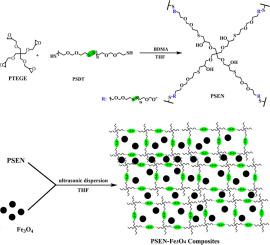Reactive & Functional Polymers ( IF 4.5 ) Pub Date : 2020-09-28 , DOI: 10.1016/j.reactfunctpolym.2020.104744 Qi Fu , Qiming Yan , Lizhang Lv , Heqing Fu

|
Magnetic nanocomposite material has undergone significant development in the past few years. However, it is inevitable to initiate mechanical damage during service. Herein, we developed a self-healing magnetic nanocomposite material composed of Fe3O4 nanoparticle and disulfide-based epoxy resin with N,N-dimethylbenzylamine (BDMA) as catalyst. Owing to the catalytic effect of BDMA, the polymer network of the material is successfully formed via thiol-epoxy click reaction of pentaerythritol glycidyl ether (PTEGE) and polydisulfide dithiol (PSDT). More strikingly, BDMA could also catalyze the metathesis reaction of aliphatic disulfide bond and the magnetic nanocomposite material shows more than 60% self-healing efficiency at room temperature for 24 h. The self-healing performance of the magnetic nanocomposite material is investigated and the possible mechanism of disulfide metathesis catalyzed by BDMA is proposed. Besides, with the incorporation of 3 wt% Fe3O4 nanoparticle, the mechanical strength and saturation magnetic induction of the magnetic nanocomposite material are up to 0.31 MPa and 0.51 emu/g, respectively. These results demonstrate that the as-prepared magnetic nanocomposite material has excellent comprehensive performance and can be used for the next generation magnetic material.
中文翻译:

通过硫醇-环氧点击反应引入的磁性自修复纳米复合材料
磁性纳米复合材料在过去的几年中经历了重大的发展。但是,在维修过程中不可避免地会引起机械损坏。在这里,我们开发了一种由Fe 3 O 4纳米颗粒和二硫化物基环氧树脂与N,N组成的自修复磁性纳米复合材料。-二甲基苄胺(BDMA)作为催化剂。由于BDMA的催化作用,该材料的聚合物网络是通过季戊四醇缩水甘油醚(PTEGE)和聚二硫二硫醇(PSDT)的硫醇-环氧点击反应成功形成的。更惊人的是,BDMA还可以催化脂肪族二硫键的复分解反应,并且磁性纳米复合材料在室温下24小时内显示出60%以上的自愈效率。研究了磁性纳米复合材料的自愈性能,并提出了BDMA催化二硫化物复分解的可能机理。此外,掺入3重量%的Fe 3 O 4。纳米颗粒,磁性纳米复合材料的机械强度和饱和磁感应强度分别高达0.31 MPa和0.51 emu / g。这些结果表明,所制备的磁性纳米复合材料具有优异的综合性能,并且可以用于下一代磁性材料。





















































 京公网安备 11010802027423号
京公网安备 11010802027423号